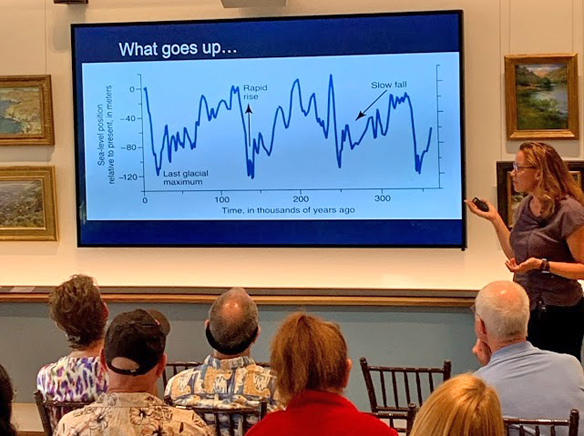
In the Catalina Island Conservancy’s Last Friday Lecture Series, USGS Pacific Coastal and Marine Science Center Oceanographer Juliette Finzi Hart discussed the realities of sea level rise and what it means for Catalina Island. Current global projections show rapidly increasing levels of sea level rise; however, there is still time to come together to make a difference.
According to Finzi Hart, there are two main factors that cause sea level rise. One of those is directly related to the earth warming: water expanding and the melting of land-based glaciers. As the air gets warmer, water temperatures rise causing it to take up more space. Additionally, ice sheets and land-based glaciers are melting, with the water coming into the ocean also contributing to sea level rise. There are other factors that contribute locally. At a geologic scale, plate tectonics can contribute to what we see locally, as whether or not the plate is subsiding or rising can influence what’s happening on our shores.
“There are a lot of different factors,” said Finzi Hart, including glacial and interglacial periods. There is a normal, natural cycle. “While we’re not necessarily causing that, what we are influencing is the rate at which that is happening.”
She presented research that showed that in the early part of the 20th century, sea level rise was about 0.6 millimeters annually. Between the 1920s until about 2000, the rate held relatively steady at about 1.4 mm per year. However, “the last couple decades is where we’re starting to see this increase up to about 3 mm per year, doubling from just 30 years ago.” While 3 mm seems like a small figure, it accumulates. “The problem is that we don’t know what happens in the future,” she added.
The State of California is active in helping coastal communities try to get a sense of what to expect in the future. Research predicts that by 2030, we’re looking at 2-12 inches of sea level rise; projections to 2050 see 5-24 inches of sea level rise; while by 2100, the sea level could rise by 17-66 inches.
These ranges “have a lot to do with what we, globally, do with our emissions,” said Finzi Hart. She stated that if the Paris Agreement, an agreement with the United National Framework Convention on Climate Change (UNFCCC) addressing greenhouse-gas-emissions mitigation, were followed, the resultant sea level rise may stay at a steady pace. Different amounts of carbon mitigation lead to different projections.
“Right now, short of action at the global scale, starting locally, we’re going to have to start planning for these higher numbers, because that’s the path we’re on,” said Finzi Hart.
There are several resources to help understand and visualize sea level rise. Our Coast, Our Future (ourcoastourfuture.org) provides online maps and tools to anticipate local vulnerabilities to sea level rise. The interactive technology allows you to input an address and then project different levels of sea level rise to see how the area will be affected. Finzi Hart also brought a virtual reality headset that attendees could use for an immersive experience.
“At about 100 centimeters the water starts to trickle in, then at 150 centimeters is where you see this really big switch,” she said. “What we would call this is a tipping point. Somewhere between 1-1.5 meters, or about 3-4 feet, of sea level rise is where a lot of the potential vulnerability comes.”
Though it may not sound like it at first, Finzi Hart emphasized that there is good news. “What this is saying is that you have time,” she said. “There’s time to plan and make decisions slowly and deliberately and with everyone’s input, really trying to think about what’s best for the community.”
Options moving forward fall into three camps: accommodation, protection and retreat. Accommodation could include elevating structures, while protecting includes soft approaches like beach nourishment and sediment management, as well as hard structures like seawalls and revetments. Retreat, like it sounds, is moving structures.
Finzi Hart says that communities are starting to plan for this uncertain, certain future. The City of Avalon publicly posts resources and a Community Plan at CityofAvalon.com/SLR.
“This is ultimately your community,” she said. “The more informed you are and the more you can have this informed conversation with your city leaders, the more it’s going to result in a solution that everyone wants.”
The next Catalina Island Conservancy Last Friday Lecture Series will be on September 27 at the Trailhead at 5:30 p.m. The September lecture features Southern California Conservation Program Specialist Colleen Wisinski from the San Diego Zoo Institute for Conservation Research who will discuss the Burrowing Owl and what is being doing to save this species.









